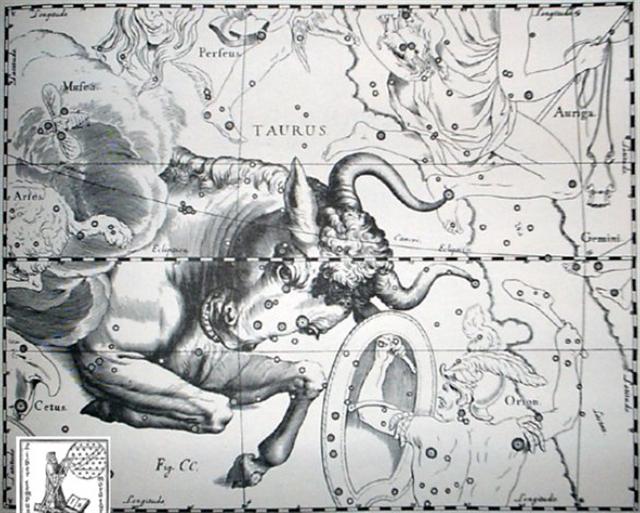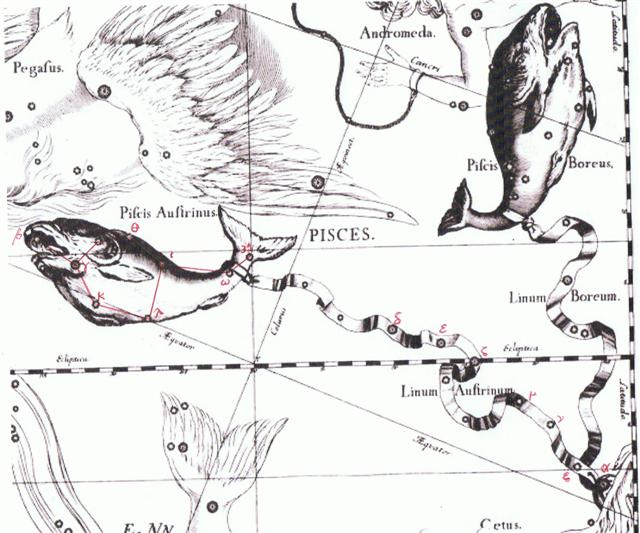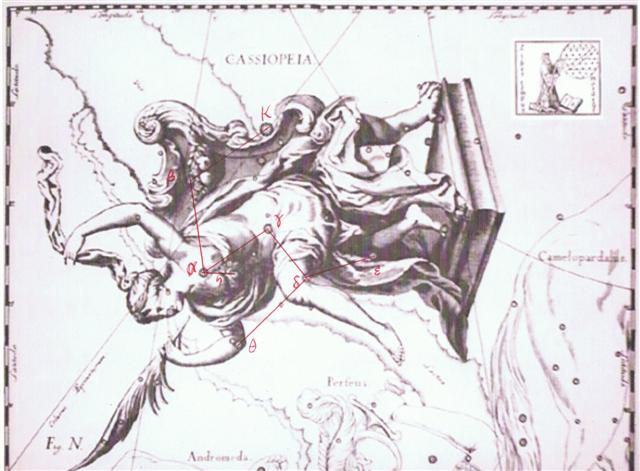Side b on the Mamari tablet has the glyph of 'breaking apart' in position 6 and on side a position 6 is occupied by a similar (for the experienced eye) glyph:
The central position in Ca1-6 has a figure with a great water drop on his chest (tagata honui according to Metoro). The star time was out in the 'sea' with 3 weeks remaining until 'land' would be reached at the First Point of Aries. The central position in Cb1-6 has a rakau (tree). Trees grow on dry land and not out in the sea. This 'tree' has a string with 5 feathers at left and another string with 2 upside down feathers at right. There are 5 days at left and 2 in front and together with day 398 it becomes 8. The front side of the year can be counted as 400 (Cb1-8) - 8 (Ca1-8) = 392 days, equal to the number of glyphs on side a of the tablet. Ca1-6 seems to illustrate how the power of spring is pushing earth (left) and sky (right) apart, after 5 dark nights in 'close embrace': ... In the beginning were Rangi and Papa, Sky and Earth. Darkness existed. Rangi adhered over Papa his wife. Man was not. A person arose, a spirit who had no origin; his name was Rangitokona, the Heaven-propper. He went to Rangi and Papa, bid them go apart, but they would not. Therefore Rangitokona separated Rangi and Papa, he thrust the sky above. He thrust him with his pillars ten in number end to end; they reached up to the Fixed-place-of-the-Heavens. After this separation Rangi lamented for his wife: and his tears are the dew and the rain which ever fall on her. This was the chant that did the work: Rangitokona, prop up the heaven! // Rangitokona, prop up the morning! // The pillar stands in the empty space. The thought [memea] stands in the earth-world - // Thought stands also in the sky. The kahi stands in the earth-world - // Kahi stands also in the sky. The pillar stands, the pillar - // It ever stands, the pillar of the sky. Then for the first time was there light between the Sky and the Earth; the world existed. From the words of Metoro I have deduced the type of glyph with an inside 'sky-propper' (Y) sign should be read as kahi:
As to the 'thought', memea, which arrives just prior to kahi in the chant it fits rather well with the mea ke type of glyph:
There are 2 + 4 feathers in front in Cb1-6 and counting from Cb1-9 we could pehaps expect 4 more days from Ca1-9:
Rei in Ca1-11 can be read either as April 1 or as a reference to 'March 5 in the times of Al Sharatain. 91 - 27 = 64. On side b the corresponding day in the times of Al Sharatain was 'September 30. In rongorongo times it was day 300 (October 27). The birds in Ca1-9 and Ca1-12 show they belong together. Then comes Ca1-13 which visualizes a 'crack in time'. In Cb1-13 there is a pair which is a unit, the opposite of what we can see in Ca1-13. The birds with poor wings in Ca1-9 and Ca1-12 are not of the manu rere type, they seem to be earth-bound:
The explanation is given in the Moriori creation chant:
I have no word hakagana in my list, but possibly it means to create (haka-) the night sky roof (-gana):
The matter in a way could become more clear if we consider what stars rose with the Sun (side a) respectively were close to the Full Moon (side b):
The back side of Andromeda's head was at α (a letter based on the head of the Bull although the star name Sirrah means the 'Navel of the Horse', Al Surrat al Faras, according to Allen):
Once upon a time, a long time ago, it was indeed the head of the Bull which broke through the morning mists at spring equinox:
Since then the Sun had reached the equinoxes and solstices earlier and earlier in the year compared to the stars. The era of Taurus had changed to an era of Aries and then, in rongorongo times, the journey had reached Pisces. In the Arab system we can see that there were 8 days from Sirrah at 0h to Delta (δ Andromedae) and a furher 3 days from there to η Andromedae at April 1 (and at Ca1-11):
From April 1 to May 23 there were 143 - 91 = 52 days and this corresponds to 52 * 71 = 3692 precessional years. However, we must add 11 days or 11 * 71 = 781 precessional year in order to count from March 21 (80) = the northern spring equinox. If we should count rongorongo time as 1842 A.D., then Hyadum I would have been at 0h around the year (3692 + 781) + 1 - 1842 = 2632 B.C. The distance from Hyadum I at 0h to Sheratan at 0h would have been around (143 - 107) * 71 = 36 * 71 = 2556 precessional years, and 2632 B.C. - 2556 = 76 B.C. The Arab system had 11 days from spring equinox to April 1 (and heliacal η Andromedae down at the back side of the northern fish in Pisces). The Gregorian calendar has 11 days from winter solstice in December 21 (355) to January 1 (366). If anciently a similar method was common, then the era of Taurus would have been not around 2632 B.C. but around 2632 B.C. - 11 * 71 = 1851 B. C., with the era of Aries about halfway from that of Taurus to that of Pisces.
Andromeda was 'earth-bound', with Sirrah at a corner of the Pegasus Square. ... Andromeda, the Woman Chained ... represents in the sky the daughter of Cepheus and Cassiopeia, king and queen of Aethiopia, chained in exposure to the sea monster as punishment of her mother's boast of beauty superior to that of the Nereids ... Her mother Cassiopeia had Achird (η) at her right breast and Cih (γ) in her lap:
... Cassiopeia, or Cassiope, more correctly Cassiepeia, although variously written, is one of the oldest and popularly best know of our constellations, and her throne, 'the shinie Casseioppeia's chair', of Spencer's Faerie Queen, is a familiar object to the most youthful observer. It is also known as the Celestial W when below the pole, and the Celestial M when above it ... To turn W into M expresses time in the vertical dimension, to move from Achird (η) to Cih (γ) is more of a horizontal movement. ... Allen does not mention Achird and he has no other name for η Cassiopejae, but I guess the star could be connected with α Leonis, Regulus, once named Achir (Possessing Luminous Rays): 'Naturally sharing the character of its constellation as the Domicilium Solia, in Euphratean astronomy it was Gus-ba-ra, the Flame, or the Red Fire, of the House of the East; in Khorasmia, Achir, Possessing Luminous Rays; and throughout classical days the supposed cause of the summer's heat, a reputation that it shared with the Dog-star.' We can summarize by arranging stars and glyphs in parallel:
The star positions have to be adjusted 1 step ahead to get them in parallel with the glyphs, because their days were not completed until midnight (time flows). These 5 dark nights are following the 8 first. The central (important) among them is 'March 5 (64) or April 1 (91), the night when Achird demonstrated her - female because of the added 'd' in her name - power. Beyond η Cassiopeiae (Achird) came η Andromedae - which touched the back side of the northern fish in Pisces and where the Arabs evidently may have had their time zero. As Metoro expressed it: 'kua hakagana' - who created the night sky. Cih (from the Chinese word for 'whip') could have set the calendar time in motion: ... At the beginning of 44 B.C. - when Ceasar was still alive - the Senate decided to raise statues of him in all the temples and to sacrifice to him on his birthday in the month Quintilis, which in honour of him was renamed July. He was raised to the status of a god (among the other gods of the state) under the name Jupiter Julius. Marcus Antonius, who this year was consul together with Ceasar, became high priest and responsible for the ceremonies. In the middle of February, at the time of the old feast of Lupercalia, he ran around naked (except for a girdle - like a maro), and whipped the Roman ladies with thongs made from goat-skin, in order to promote ('kick' - Rei), their fertility ... The old feast of Lupercalia may have originated around day 31 (January) + 14 (February) = 45 (= 360 / 8) counted from January 1. The time could have been around 71 * (66 - 45) = ca 1500 B.C. when Cih rose with the Sun in the middle of February. | ||||||||||||||||||||||||||||||||||||||||||||||||||||||||||||||||||||||||||||||||||||||||||||||||||||||||||||||||||||||||||||||||||||||||||||||||||||||||||||||||||||||||||||||||||||||||||||||||||||||||||||||||||||||||||||||||||
















